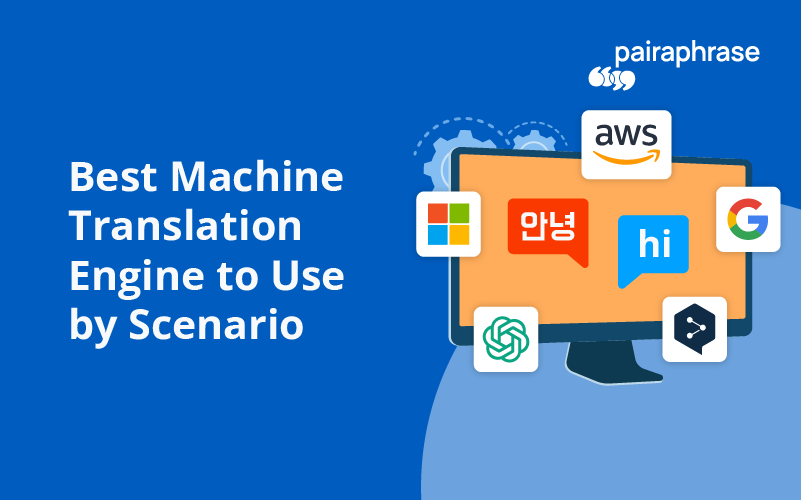Best Machine Translation Engine to Use by Scenario
 Colin Reed
Colin Reed
Choosing the best Machine Translation engine isn't as simple as picking the most popular name—you need a solution that fits your content type, subject matter, and workflow.
In addition, your organization is expanding, and with it, the need for accurate, fast, and cost-effective translation. So selecting the right Machine Translation engine is a crucial step for achieving accurate and context-appropriate translations. As translation industry veterans, we’ve witnessed the consequences that follow when an organization skips this step.
Today’s article explores the various AI-driven engines readily available for translation and provides guidance on choosing the best one for specific content types, subject matters, and activities. For example, Transcreation versus pure translation.
This way, you won’t make the same mistake that causes many teams to wish they took the time to choose the right translation engine for specific projects.
What you'll learn
In this guide, we’ll cover several key areas to help you make informed decisions about Machine Translation:
How Machine Translation engines work
Which translation engines work best for your specific needs
The strengths and limitations of OpenAI, DeepL, AWS, Google, and Microsoft
How to improve Machine Translation quality
Choosing the best Machine Translation engine to use by scenario
1. Understand Machine Translation engines
As we briefly mentioned above, not all Machine Translation engines are built the same. Some excel in preserving nuance, others integrate seamlessly with your workflow, and some are best for technical content.
AI vs. Human Translation: Where do Machine Translation engines fit?
Machine Translation is fast and cost-effective, but human translators bring essential cultural and contextual expertise. A recent study found that while AI can deliver high accuracy, human review is still key– particularly for nuanced, creative, or legal content.
Therefore, choosing the right translation engine ensures better results to minimize human review. This first step will help you balance speed, cost, and quality.
2. Choose the right translation engine for your needs
Content-type-specific engines
Different engines excel in different types of content. For instance, legal documents require high accuracy and confidentiality, making Microsoft and Google preferred options due to their robust security measures and specialized legal terminologies.
Technical manuals might benefit from AWS's extensive technical glossary, while creative content for marketing could find DeepL's nuanced language capabilities more beneficial. See below for a complete breakdown.
Subject matter expertise
Subject matter expertise is critical in translation. For financial documents, Google's and Microsoft's engines, known for their precise handling of economic terminology, are ideal. In contrast, medical translations demand extreme accuracy, where AWS and DeepL’s specialized medical vocabularies come into play.
Note: Medical translations with Machine Translation should be approached safely and under high scrutiny.
Recommendations based on activity
When it comes to activities, translating straightforward texts such as emails or general web content can be efficiently handled by any of the provided engines. However, for Transcreation, where the translation involves creative rewriting, DeepL or OpenAI might be more suitable due to their superior understanding of context and idiomatic expressions.
See below for a quick breakdown of the best machine translations for specific contents.
Comparison of popular Machine Translation engines
Which translation engine to use for… | Your best Machine Translation option | Why this engine is best |
Technical Documentation | → AWS Translate | Custom terminology support, domain adaptation |
Financial & Economic | → Google Translate, Microsoft Translator | Economic terminology, high accuracy |
General Business Communication | → Any; Google Translate, Microsoft translate | Fast, broad language coverage |
Marketing & Creative Content | → DeepL, OpenAI | Natural fluency, transcreation capabilities |
Medical | → DeepL, AWS Translate | Specialized medical vocabulary |
Legal & Compliance Materials | → DeepL, AWS Translate | High accuracy, controlled terminology |
Conclusion
Selecting the right Machine Translation engine is a strategic decision that directly impacts translation quality, efficiency, and cost. By aligning the engine with your content type, subject matter, and specific translation activities, you can achieve more accurate and context-aware results. This guide helps you navigate the strengths of each engine so you can avoid costly missteps and make informed choices that support your organization’s global communication goals.
Source: This blog was originally published at pairaphrase.com
Subscribe to my newsletter
Read articles from Colin Reed directly inside your inbox. Subscribe to the newsletter, and don't miss out.
Written by
